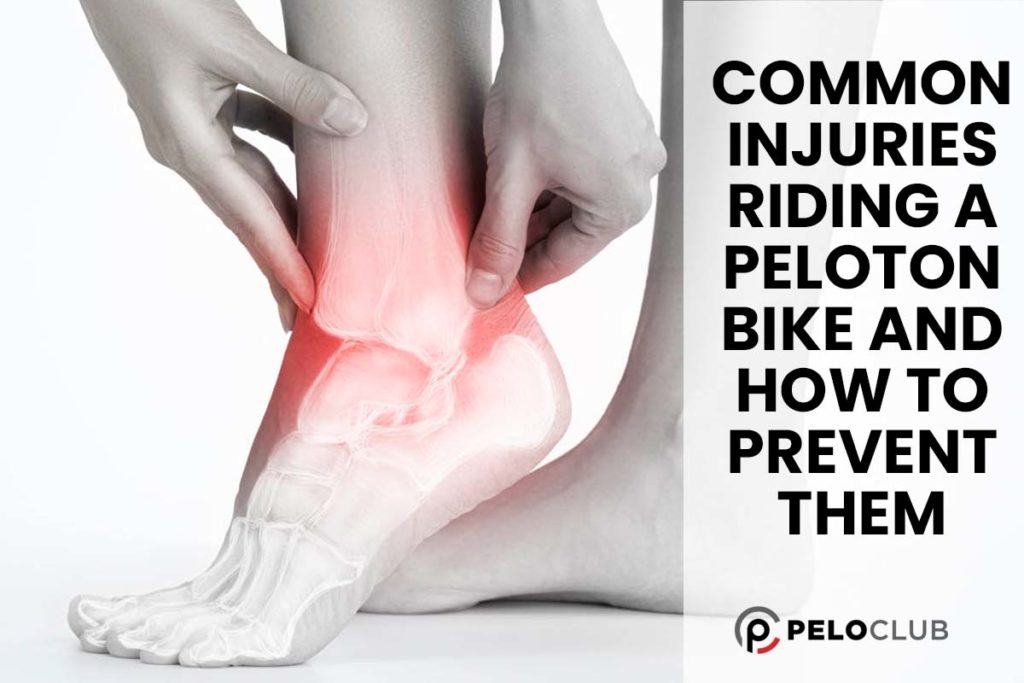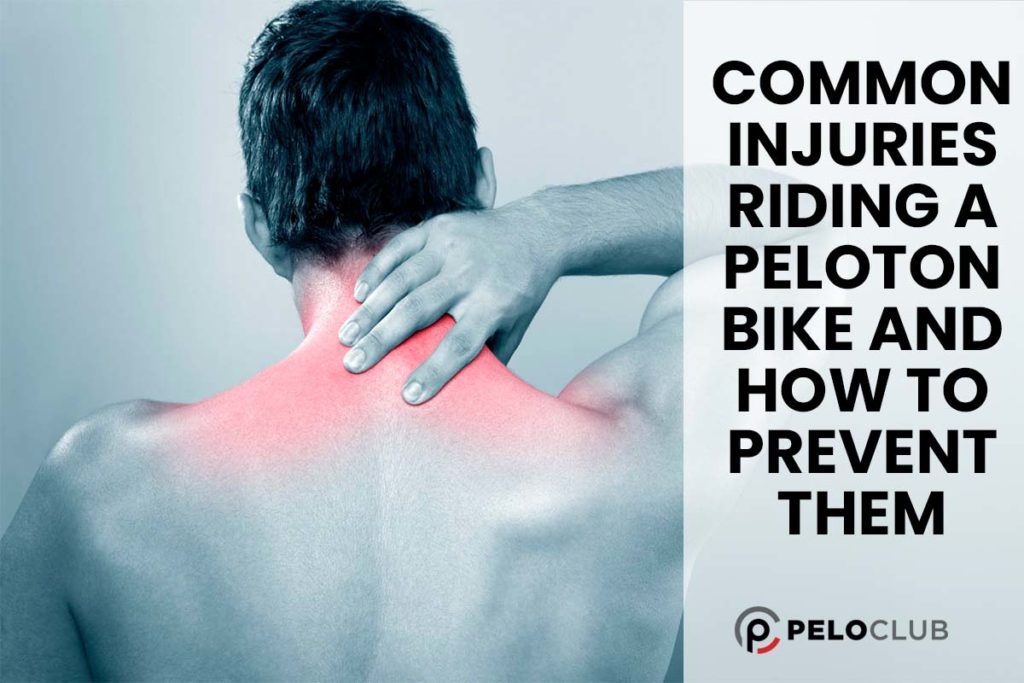
Do you want to find out the common cycling injuries from riding a Peloton Bike? Are you interested in learning how to prevent common cycling injuries when riding your Peloton?
The most common cycling injuries from riding a Peloton Bike include knee pain, back pain, saddle sore, wrist pain, and ankle pain. However, most injuries can be easily prevented by adjusting the positioning of your Peloton Bike, relaxing your posture, building core strength in between sessions, and making sure you stretch your muscles before and after riding.
Read on to find out more about the most common cycling injuries people get from riding their Peloton Bikes and to learn about how you can prevent these injuries.
What are the main injuries people get from riding a Peloton Bike?
Many common types of pain result from riding a Peloton Bike. Usually, there are easy fixes to the pain.
Using a Peloton Bike is a full-body workout – you heavily engage your legs and your core, but you also use your back, arms, and shoulders for balance and movement.
Depending on the type of pain and which part of your body experiences the pain, you may be able to prevent it by adjusting your bike setup, taking classes, doing strength workouts, and stretching.
Remember that if you experience severe pains, you should seek medical advice as you may have an injury that needs treatment.
Lower back pain
People most commonly suffer from lower back pain after riding their Peloton Bike. Pain in the lower back could be caused by issues with your position when riding the bike.
If you have a heavily tilted forward position while riding, this can put too much pressure on your lower back.
It’s also known that as you get increasingly tired on the bike, your posture can become more slouched on the bike, which can put further pressure onto your lower back as a result.
Weaker core strength is a common cause of lower back pain. If you don’t have a strong enough core, your back muscles will have to overcompensate to keep you balanced.
You need your core muscles to do the hard work to keep you upright when you’re riding. If your back has to do this work, you will end up with severe pains.
Preventing lower back pain
Adjust your position on the bike so that you are not tilted too forward or have to reach out too much for your handlebars.
Work out your core in between Peloton Bike sessions. Using your Peloton membership, you could attend classes to help you build core strength.
Strengthening your core will help protect your lower back when you’re riding.
Upper back and shoulder pain
It’s also possible to experience pain in your upper back and shoulder when riding your Peloton.
When you’re riding on a hard session, it can be tempting to raise your shoulders forward towards your ears. Unfortunately, this tension will reduce blood flow to your shoulder muscles as you are tensing the muscles heavily.
Preventing upper back and shoulder pain
The muscle tension and contraction for long periods when riding the Peloton means you need to stretch your upper back and shoulders properly in between rides to release tension.
Think about your position on the bike: are your shoulders rising closer and closer to your neck and ears as you ride?
If so, this will increase the tension and cause pain and soreness. Try and stay aware during your sessions of maintaining a strong posture with your shoulders relaxed and down, instead of tense and close to your neck.
Neck pain

Having a stiff neck after riding is very common for Peloton riders.
Similar to upper back and shoulder pains, neck pains are caused by incorrect position on the bike and a form that creates high amounts of tension in the neck.
If you hold a lot of tension in your neck in your daily life, this will worsen when you’re on the bike as these muscles are contracted while riding.
Preventing neck pain
Make sure your shoulders are relaxed and pulled back to prevent tension from building up.
Stretch after each session on your Peloton Bike to give your neck the tension relief it needs.
Adjust your handlebars if necessary – if your handlebars are too far from your body when you’re riding, you will be reaching forward very far, and this will put unnecessary pressure on your neck.
Hip pain
Peloton Bike workouts are known for causing tight hips. This is because when you’re riding, your hips are engaged in a very repetitive motion back and forward for the whole session, which can cause muscle tightness and tension.
As with your back and neck, your hip muscles can become very contracted after sessions.
Preventing hip pain
Building up flexibility in the hips is essential to prevent hip pain riding your Peloton. Try some on-the-floor mat exercises which will open up your hips before you ride.
Backside (saddle sore)
If you’re new to riding or are engaging in high-intensity workouts, you may start to feel saddle sore.
Preventing saddle sore
Make sure your Peloton Bike is set up in a suitable position for you. For example, the seat should be level.
You might have unnecessary tension in your backside if your saddle is too high, as this will mean your knees are becoming too compressed on upward pedals, and then your legs are reaching down too far on downward pedals.
This will mean your glutes and backside are being overworked, and it will be painful, so make sure you adjust your saddle accordingly.
Knees
Knee pain is one of the most commonly experienced pain caused by riding a Peloton Bike.
Pain can be felt in the front and back of the knees, but luckily, this can be easily fixed by adjusting your bike seat and cleats. There’s a whole article on this subject that you can find here.
Wrist and hands
Your wrists and hands will feel sore if your bike saddle is too high, meaning you are thrusting your weight forward and putting high levels of pressure onto your wrists and hands.
Preventing wrist and hand pain
Move your bike saddle back and make sure your handlebars aren’t too low, causing you to put all of your weight onto your wrists.
When riding your Peloton, you should not feel like your weight is resting on your wrists or upper body.
Arm pain
People often experience arm and elbow pains when riding as their arms are usually in one position for the whole ride, resulting in a build-up of tension.
Preventing arm pain
Make sure your handlebar is not too far of a reach, as this will create pressure on your arms.
Try not to let your elbows lock while riding – holding your muscles in a contracted position for an extended period of time will be painful. This means you should try to loosen your grip and relax your elbows during your ride.
Foot pain
It’s possible to experience foot pain when riding because your legs move quickly during rides, and you use your feet to push the pedals on downstrokes.
Preventing foot pain
Try lowering your saddle, as foot pain can signify that your bike seat is too high, and you have to overreach to pedal downwards. Also, make sure your shoes are the correct size.
You’ll know if you are over-reaching with your feet if you have to point your toes down when pedaling downwards entirely.
Ankles and Achilles
Ankle and Achilles pain can be caused by incorrect positioning of your feet on the pedals.
Preventing ankle pain
As with foot pain, there’s a potential that your ankle pain is caused by overreaching due to a high saddle. Lower your saddle to fix this.
You will also benefit from stretching, particularly focusing on stretching your lower legs, as this will release any tension built up when riding.
Delayed onset muscle soreness (DOMS)
DOMS is muscle pain that you may experience after working out on your Peloton Bike.
DOMS is caused by inflammation due to you working out your muscles with high intensity. It will usually set in the day after working out and last for two days.
When you experience DOMS, you must keep your body moving and stretch your muscles. The soreness will turn into stiffness if you don’t keep moving.
Take a couple of days off intensive workouts, and perhaps try yoga or a long walk to keep your blood flowing.
Post Injury Advice
If you experience pains due to riding your Peloton, you should take a few days to rest off the bike to allow your body to recover.
To reduce pain, you can use an ice pack to ease swelling on areas that feel swollen or warm. Likewise, use a heat pack on sites that feel stiff and tight to help relax the muscles.
